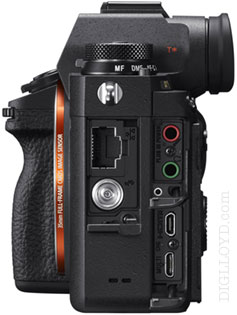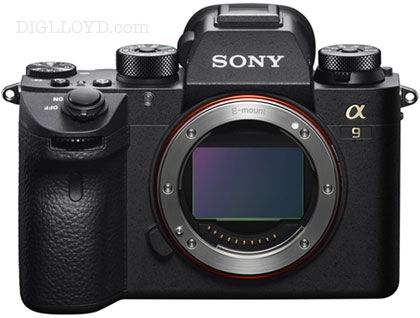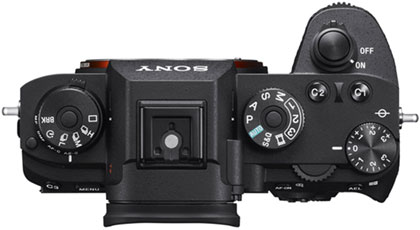Sony’s New α9 Camera Appears to Target the High-End Sport Shooter Market
Get the about $4499 Sony a9 and about $2499 Sony FE 100-400mm f/4.5-5.6 GM OSS at B&H Photo.
I have to laugh a little—starting a few years ago I posited breakthroughs that would challenge the best DSLRs even for sports shooting. I remember many a reader email admonishing me that the blackout issues, the phase detect focusing challenge, etc all made mirrorless inferior and would not be beaten anytime soon, if ever. I had total faith that this viewpoint was in serious error, and even if this new A9 fails in some area(s), time will take if far forward, leaving DSLRs in the dust if indeed that is not now already the case.

And so here it is complete with zero blackout, 20 fps for 241 RAW images, 693 focus points with 93% frame coverage over far more of the frame than any DSLR can manage, phase-detect (!) autofocus, silent and vibration-free shooting, in body image stabilization (IBIS), 4K video, enhanced pro support services, and more.
I had to do a double take: this is an E-mount camera taking FE lenses from what I understand, so it is a perfect complement to the Sony A7R II. The death knell for the DSLR?
The use of phase-detection points also enables the use of A-mount lenses via the optional LA-EA3 or LA-EA1 lens mount adapters with full continuous AF/AE tracking compatibility.
I have said that Sony was gunning for DSLRs, and this is clearly the case with the A9—the finally “victims” are in the crosshairs: high end sport shooter DSLRs.
The about $4499 price is in the same territory as the high-end pro DSLR cameras, so even the price is consonant with the area of application.
Also announced is the new about $2499 Sony FE 100-400mm f/4.5-5.6 GM OSS.
Any revision to the Sony A7R II will surely see at least some of the improvements seen in this new camera—I am hoping the zero blackout feature at last.
- EVF Mirrorless vs DLSR
- Sony’s Take on the Camera Market
- Olympus OM-D E-M1 Mark II: Sport Shooter’s Dream?
- Reader Comments: Lenses for Sports Photography
- Reader Question: Nikon or Sony?
- Evaluated: “Sony, Fix These Things and Win” aka How Does the Sony A7R II Stack Up?
Sony’ press release below. Emphasis added
Groundbreaking Full-frame Mirrorless Camera Delivers Unmatched Speed, Versatility and Usability
- World’s First1 full-frame stacked CMOS sensor, 24.2 MP2 resolution
- Blackout-Free Continuous Shooting3 at up to 20fps4 for up to 241 RAW5/ 362 JPEG6 images
- Silent7, Vibration-free shooting at speeds up to 1/32,000 sec8
- 693 point focal plane phase detection AF points with 60 AF/AE tracking calculations per second
- Extensive professional features including Ethernet port for file transfer, Dual SD card slots and extended battery life
- 5-Axis in-body image stabilization with a 5.0 step9 shutter speed advantage
... Sony Alpha α9 aka ILCE-9
Sony Alpha α9 aka ILCE-9NEW YORK, Apr. 19, 2017 – Sony Electronics, a worldwide leader in digital imaging and the world’s largest image sensor manufacturer, has today introduced their new revolutionary digital camera, the α9 (model ILCE-9).
The most technologically advanced, innovative digital camera that Sony has ever created, the new α9 offers a level of imaging performance that is simply unmatched by any camera ever created – mirrorless, SLR or otherwise.
The new camera offers many impressive capabilities that are simply not possible with a modern digital SLR cameras including high-speed, blackout-free continuous shooting at up to 20 fps, 60 AF/AE tracking calculations per second, a maximum shutter speed of up to 1/32,000 seconds and much more. These are made possible thanks to its 35mm full-frame stacked Exmor RS™ CMOS sensor – the world’s first of its kind – which enables data speed processing at up to 20x faster than previous Sony full-frame mirrorless cameras11. This unique sensor is paired with a brand new, upgraded BIONZ X processing engine and front end LSI that maximizes overall performance.
This industry-leading speed and innovative silent shooting7 is combined with a focusing system that features an incredible 693 phase detection AF points. Covering approximately 93% of the frame, the focusing system ensures that even the fasting moving subjects are reliably captured and tracked across the frame.
The new α9 also features a vibration free, fully electronic, completely silent anti-distortion shutter with absolutely no mechanical mirror or shutter noise, making it an extremely powerful photographic tool for any shooting situation that demands quiet operation. To ensure maximum usability and reliability, the camera features a new Z battery with approximately 2.2x the capacity of W batteries, as well as dual SD media card slots, including one that supports UHS-II cards. An Ethernet port (wired LAN terminal) is available as well, and there is a wide variety of new settings, controls and customizability options that are essential for working pros.
“This camera breaks through all barriers and limitations of today’s professional digital cameras, with an overall feature set that simply cannot be matched considering the restrictions of mechanical SLR cameras” said Neal Manowitz, Vice President of Digital Imaging at Sony Electronics. “But what excites us most about the α9 – more than its extensive product specs – is that it allows professionals to see, follow and capture the action in ways that were never before possible, unlocking an endless amount of new creative potential.”
A New Standard of Speed and Focusing Accuracy
 Sony Alpha α9 aka ILCE-9
Sony Alpha α9 aka ILCE-9Critical to the record-breaking speed of the new α9 is the combination of the new stacked 24.2 MP2 Exmor RS image sensor, new BIONZ X processor and front end LSI.
The immense processing power from these new components allows for faster AF/AE calculation while also reducing EVF display latency. The processor and front end LSI are also responsible for the larger continuous shooting buffer, enabling photographers to shoot at a blazing 20 fps4 with continuous AF/AE tracking for up to 362 JPEG6 or 241 RAW5 images.
The camera’s innovative AF system tracks complex, erratic motion with higher accuracy than ever before, with the ability to calculate AF/AE at up to 60 times per second(10), regardless of shutter release and frame capture. Further, when the shutter is released while shooting stills, the electronic viewfinder functions with absolutely no blackout, giving the user a seamless live view of their subject at all times (12). This feature truly combines all of the benefits of an electronic viewfinder with the immediacy and “in the moment” advantages that not even the finest optical viewfinders can match, and is available in all still image modes including high speed 20 fps4 continuous shooting.
With 693 focal plane phase detection AF points covering approximately 93% of the frame, the camera ensures improved precision and unfailing focus in scenes where focus might otherwise be difficult to achieve. The Fast Hybrid AF system – pairing the speed and excellent tracking performance of phase detection AF with the precision of contrast AF – achieves approximately 25% faster performance when compared with α7R II, ensuring all fast-moving subjects are captured.
Professional Capabilities in a Compact Body
Sony’s new full-frame camera is equipped with a variety of enhanced capabilities that give it a true professional operational style.
The α9 features an all-new, high-resolution, high-luminance Quad-VGA OLED Tru-Finder with approximately 3,686k dots for extremely accurate, true-to-life detail reproduction. The new Tru-Finder, which is the highest resolution viewfinder ever for a Sony α camera, incorporates an optical design that includes a double-sided aspherical element, helping it to achieve 0.78x magnification and a level of corner to corner sharpness that is simply outstanding. The EVF also utilizes a ZEISS® T* Coating to greatly reduce reflections, and has a fluorine coating on the outer lens that repels dirt.
This all adds up to a luminance that is 2x higher than the XGA OLED Tru-Finder from the α7R II, creating a viewfinder image with a brightness level that is nearly identical to the actual scene being framed, ensuring the most natural shooting experience. The frame rate of the Tru-Finder is even customizable, with options to set it for 60 fps or 120 fps13 to best match the action.
The α9 is equipped with an innovative 5-axis image stabilization system that provides a shutter speed advantage of 5.0 steps 9, ensuring the full resolving power of the new sensor can be realized, even in challenging lighting. Also, with a simple half press of the shutter button, the effect of the image stabilization can be monitored in the viewfinder or on the LCD screen, allowing framing and focus to be accurately checked and continually monitored.
The α9 also offers an Ethernet port (wired LAN terminal), allowing convenient transfer of still image files to a specified FTP server at high-speed, making it an ideal choice for studio photography, high-profile news and sporting events and more. There is a sync terminal as well, enabling external flash units and cables to be connected directly for convenient flash sync.
New Features for Fast Operation
Sony’s new α9 has several new and updated focus functions that support faster, easier focusing in a variety of situations. The camera features a multi-selector joystick on the back of the camera, allowing shooters to easily shift focus point within the frame by pressing the multi-selector in any direction up, down, left or right when shooting in Zone, Flexible Spot or Expanded Flexible Spot focus area modes. The new model also offers touch focusing on the rear LCD screen for easily selecting of and shifting focus towards a desired focus point or subject.
New for Sony E-mount cameras, the α9 includes the addition of separate drive mode and focus mode dials, plus a new “AF ON” button that can be pressed to activate autofocus directly when shooting still images or movies.
Additional new capabilities include the “AF Area Registration”, which allows frequently used focus area to be memorized and recalled via custom button assignments. There is also the ability to assign specific settings (exposure, shutter speed, drive mode, etc) to a custom button to be instantly recalled when needed. The camera can memorize and automatically recall the last focus point used in a vertical or horizontal orientation as well, instantly switching back to it when that specific orientation is used again.
For enhanced customization, a “My Menu” feature is available, allowing up to 30 menu items to be registered in a custom menu for instant recall when needed.
Double Battery Life, Double Memory
The innovative α9 camera features an all-new Sony battery (model NP-FZ100) with 2.2x the capacity of previous Sony full-frame models, allowing for much longer shooting performance.
Also, based on extensive customer feedback, the new camera offers two separate media card slots, including one for UHS-II media. The same data can simultaneously be recorded to both cards, or the user can choose to separate RAW / JPEG or still images / movies. Movies can also simultaneously be recorded to two cards for backup and more efficient data management.
High Sensitivity and Wide Dynamic Range
The unique design of the α9 image sensor represents the pinnacle of Sony device technology. The 24.2 MP 2 full-frame stacked CMOS sensor is back-illuminated, allowing to capture maximum light and produce outstanding, true-to-life image quality. The sensor also enables the diverse ISO range of 100 – 51200, expandable to 50 – 20480014, ensuring optimum image quality with minimum noise at all settings.
The enhanced BIONZ X processor plays a large part in image quality as well, as it helps to minimize noise in the higher sensitivity range while also reducing the need to limit ISO sensitivity in situations where the highest quality image is required.
The new α9 also supports uncompressed 14-bit RAW, ensuring users can get the most out of the wide dynamic range of the sensor.
4K Video Capture
The new α9 is very capable as a video camera as well, as it offers 4K (3840x2160p) video recording across the full width of the full-frame image sensor15, 16. When shooting in this format, the camera uses full pixel readout without pixel binning to collect 6K of information, oversampling it to produce high quality 4K footage with exceptional detail and depth. Recording is also available in the popular Super 35mm size.
Additionally, the camera can record Full HD at 120 fps at up to 100 Mbps, which allows footage to be reviewed and eventually edited into 4x or 5x slow motion video files in Full HD resolution with AF tracking17.
New Accessories
Sony has released a variety of new accessories to compliment the new α9 camera, including:
- NP-FZ100 Rechargeable Battery – high-capacity battery with approximately 2.2x the capacity of the NP-FW50 W-series battery. It also supports InfoLITHIUM® technology, making it possible to view the remaining battery power as both a percentage display and five step icon on the camera’s LCD screen.
- VG-C3EM Vertical Grip – provides same operation, handling and design as theα9 camera, doubles battery life and allows USB battery-charging via the camera body.
- NPA-MQZ1K Multi-Battery Adaptor Kit – External multi-battery adaptor kit capable of functioning as an external power supply for four Z series batteries and as a quick charger. Kit comes with two packs of NP-FZ100 rechargeable batteries.
- GP-X1EM Grip Extension – Grip extender with same look, feel and design as α9 body. Enables more solid hold on camera.
- FDA-EP18 Eyepiece Cup –eye piece cup with locking mechanism
- BC-QZ1 Battery Charger –quick-charging battery charger. Charges one new Z series battery in approximately 2.5 hours.
- PCK–LG1 Screen Protect Glass Sheet – hard, shatterproof glass screen protector with anti-stain coating to prevent fingerprints. Compatible with touch operation and tilting LCD screen
Pricing and Availability
The Sony α9 Full-frame Interchangeable Lens Camera will ship this May for about $4,500 US and $6,000 CA. It will be sold at a variety of Sony authorized dealers throughout North America.
Notes to Editors:
- As of April 19th, 2017
- Approx. effective
- Electronic shutter mode. At apertures smaller than F11 (F-numbers higher than F11), focus will not track the subject and focus points will be fixed on the first frame. Display updating will be slower at slow shutter speeds.
- “Hi” continuous shooting mode. The maximum frame rate will depend on the shooting mode and lens used. Visit Sony’s support web page for lens compatibility information.
- “Hi” continuous shooting mode, compressed RAW, UHS-II memory card. Sony tests.
- “Hi” continuous shooting mode, UHS-II memory card. Sony tests.
- Silent shooting is possible when Shutter Type is set to “Electronic” and Audio signals is set to “Off.”
- 1/32000 shutter speed is available only in the S and M modes. The highest shutter speed in all other modes is 1/16000.
- CIPA standards. Pitch/yaw stabilization only. Planar T* FE 50mm F1.4 ZA lens. Long exposure NR off.
- At shutter speeds higher than 1/125 sec, smooth and blackout-free live view images are shown in EVF.
- Compared to the front-illuminated CMOS image sensor in the α7 II.
- Display updating will be slower at slow shutter speeds.
- When the auto or electronic shutter mode is selected the viewfinder frame rate is fixed at 60 fps during continuous shooting.
- Still images, mechanical shutter: ISO 100 – 51200 expandable to ISO 50 – 204800.
Still images, electronic shutter: ISO 100 – 25600 expandable to ISO 50 – 25600.
Movie recording: ISO 100 – 51200 expandable to ISO 100 – 102400.- In full-frame shooting, the angle of view will be narrower under the following conditions: When [File Format] is set to [XAVC S 4K] and [ Record Setting] is set to [30p]
- Class 10 or higher SDHC/SDXC memory card required for XAVC S format movie recording. UHS Speed Class U3 required for 100Mbps or higher recording.
- Sound not recorded. Class 10 or higher SDHC/SDXC memory card required.
Buttons look to be very similar to the Sony A7R II, but I deem them too small and tight as compared to a Nikon or Canon pro body, and not laid out well for quick and easy access including with gloves on in cold conditions.


Reader comments
James P writes:
Unfortunately just because they announce this camera the PRO sports shooter market will still be controlled by both Nikon and Canon. Why, simply because of their PRO support, both Canon and Nikon have outstanding service to the pro users, expediting repairs, loaners and being on site for equipment issues at major events.
Sony is making nothing but disposable, cheaply made cameras that will not hold up to the demands of a working sports photographer, Period. They are toys and when they break, where do you send them, you don’t, you buy a new one. Sony is an electronics company, not a PRO camera maker. I had a A7II for all of one month, nice file, but too small and a menu system that is not user friendly, a flash system or should I say no flash system that can compete with both Nikon and Canon. It’s great to dream, but there are PRO camera makers, such as Nikon, Canon, Hasselblad, Phase and Leica that may not have all the things you want in a camera but have the most important thing that a PRO depends on and that is service of their products and support to the working PRO, those that make a livelihood using their gear depend on that.
DIGLLOYD: the market will decide this point, not assertions by me or anyone else.
I’ll be the first to agree that I Sony’s professional services program remains a weak point, but note that Sony is opening walk-in centers in Los Angelese and New York, so clearly the point is not lost on Sony. It’s a move forward, just like the A9.
As for “disposable cheaply made cameras”, I don’t dismiss an as yet unseen camera out of hand before even giving it a chance. And while I know that Sony has had some issues, my A7R II has worked flawlessly since I got it—more than I can say for Leica or Hasselblad or Fujifilm.
As for Leica being taken seriously as a 'pro' system, this is surely a joke (!) to list it with Nikon and Canon! There are/were terrible problems with the S system (now defunct), the M system has left users like me hung out to dry and the SL system is too little, too late and too little even now.
Bottom line here is that this note seems based on the past. I don’t hold the past against any vendor, if they march down the right path going forward.
Roy P writes:
The focus has always been accurate even with my A7RM2 and Canon 200-400 lens with both the internal and an external 1.4x TC, for a net focal length of 784 mm. Haven’t done pathological test cases like with low contrast subjects in very low light, but at least in reasonable light, the focus is always spot on.
The question is the speed of focus acquisition and tracking. The A7R focus acquisition is not bad with an MC-11, but the Canon 5DSR is noticeably faster, and the 1DX2 is instantaneous. So I am interested to know if this is a camera or adapter limitation, or both. So I’ll be looking at how much better the AF performance will be with the A9 , and whether the adapter makes any difference.
Nikon and Canon users have been staying with their DSLRs because mostly due to their glass investments. Also, Sony has been perceived as inspired by consumer electronics and not photography, and somewhat toy grade. I think all of that instantly changed with the A9, and there are going to be thousands of people wondering if the time has come to make a switch.
A 24MP weather sealed camera with dual cards, 20 fps, almost 700 AF points, silent shooting, unblocked view and sensor stabilization that weighs less than a half of a 1DX2 or D4/D5 is impossible to ignore. So the first question that’s likely to be running in the heads of any Nikon / Canon user who heard about the A9 is likely to be how well will my lenses autofocus with the A9. I got that exact question from a friend in the U.K. who owns a 1DX2 and 5DSR, and several Canon lenses.
I think the A9 is a whack on the head with a baseball bat for Canon and Nikon. Any 2-3 of the enhancements below would merit a switch to a different system. This list should trigger a stampede, to get out before others start putting up their gear on eBay:
- 24MP resolution, which is more important than just in landscapes, because a lot of action images are heavily cropped, esp. birds in flight. The extra pixels are invaluable in capturing detail.
- 20 fps likely doubles the yield of in-focus frames from a burst of shots
- 693 in-sensor PDAF points must be amazing
- 60 times per second focus measurement to set focus, unprecedented
- Zero black outs, so much easier to keep the subject in sight
- Silent shooting
- Large buffer size
- Half the weight and bulk
- Sony’s CEO must have told his team “Look fellas, watching a crucifixion might be entertaining, but we have a lot of work to do, and we don’t have time. Let’s just go for the slaughter.”



























